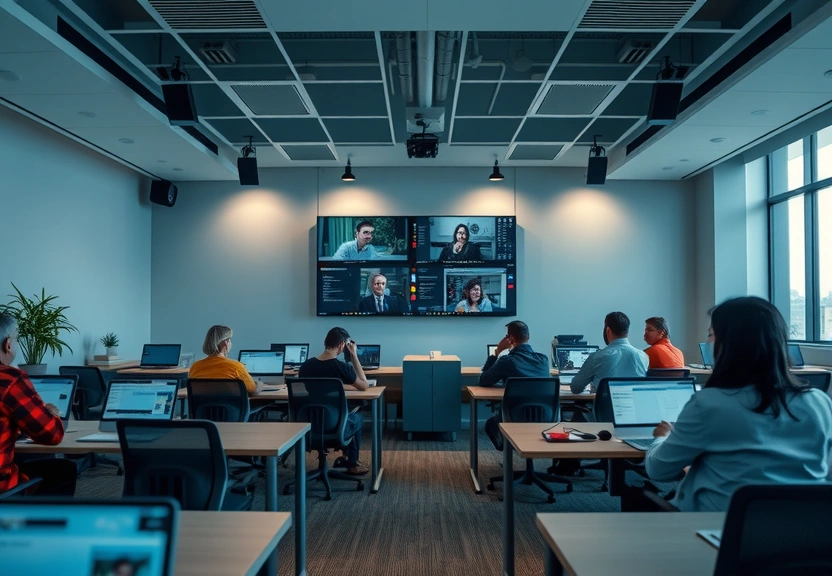Virtual Classrooms Explained: Platforms, Features, and Benefits
Introduction
In recent years, the rise of technology has transformed the educational landscape, leading to the emergence of virtual learning environments. Virtual classrooms offer a flexible, innovative approach to education, allowing learners to engage with content, instructors, and peers from anywhere in the world. This article will explore the various platforms available for virtual classrooms, their unique features, and the benefits they provide to both educators and students.

Development of Virtual Classrooms
The development of virtual classrooms has been accelerated by advancements in technology, particularly with the increase in internet accessibility and the proliferation of smart devices. Several platforms have emerged, each designed to enhance the learning experience. Popular platforms include Zoom, Google Classroom, Microsoft Teams, and Blackboard. Each of these platforms offers distinct features tailored to different educational needs.
For instance, Zoom is primarily known for its video conferencing capabilities, making it ideal for live lectures and discussions. Google Classroom, on the other hand, integrates seamlessly with other Google services, providing an easy-to-use interface for assignment management and communication. Microsoft Teams combines collaboration tools with classroom management, allowing educators to create a comprehensive virtual learning environment. Blackboard is a more traditional learning management system (LMS) that offers robust tools for course content delivery, assessments, and student engagement.
Features of Virtual Classrooms
Virtual classrooms come equipped with an array of features designed to facilitate effective learning. Some key features include:
- Real-time Communication: Platforms typically offer chat, video, and audio communication tools that allow students and instructors to interact in real time.
- Content Sharing: Educators can share presentations, documents, and videos instantly, enhancing the learning experience.
- Interactive Tools: Many platforms include interactive whiteboards, polls, and quizzes to engage students and assess their understanding.
- Recording Capabilities: Classes can be recorded for later access, providing a valuable resource for students who need to review material.
- Assessment Tools: Virtual classrooms often feature built-in assessments, enabling educators to monitor progress and provide feedback efficiently.
These features not only make learning more engaging but also cater to various learning styles, ensuring that all students have the opportunity to succeed in a virtual setting.
Analysis and Benefits
The benefits of virtual classrooms extend far beyond mere convenience. Firstly, they provide flexibility in scheduling, allowing students to learn at their own pace and on their own time. This flexibility is particularly beneficial for non-traditional students who may be balancing work, family, and education.
Secondly, virtual classrooms promote inclusivity. Students from diverse geographical locations can come together, providing opportunities for collaboration and cultural exchange. Moreover, learners with disabilities may find virtual environments more accommodating, as many platforms offer accessibility features such as screen readers and captioning.
Additionally, the use of virtual classrooms can lead to cost savings for both institutions and students. Schools can reduce overhead costs associated with physical infrastructure, while students can save on commuting and accommodation expenses. Furthermore, many virtual learning environments offer free or low-cost resources that enhance the learning experience without imposing financial burdens.
Practical Implementation
Implementing virtual classrooms requires careful planning and consideration. Educational institutions must first choose the right platform that aligns with their goals and the needs of their students. Factors to consider include user-friendliness, available features, and integration capabilities with existing systems.
Once a platform is selected, training for both educators and students is essential. Instructors should be familiar with the platform’s functionalities to deliver content effectively, while students should receive guidance on how to navigate the virtual learning environment.
Moreover, establishing a clear communication protocol is vital for fostering a supportive learning atmosphere. Regular check-ins and feedback sessions can help maintain engagement and address any challenges that may arise during the learning process.
Frequently Asked Questions
What are virtual learning environments?
Virtual learning environments (VLEs) are online platforms designed to facilitate educational experiences through various digital tools and resources. They enable students to access course materials, communicate with instructors, and collaborate with peers from remote locations.
How do virtual classrooms differ from traditional classrooms?
Virtual classrooms differ from traditional classrooms in their delivery method. While traditional classrooms involve face-to-face interactions within a physical space, virtual classrooms leverage technology to enable real-time communication and learning from anywhere, often with more flexible scheduling options.
What are the key features to look for in a virtual classroom platform?
When selecting a virtual classroom platform, key features to consider include real-time communication tools, content sharing capabilities, interactive elements, assessment tools, and recording functions. These features enhance the overall learning experience and facilitate effective teaching.
Can virtual classrooms accommodate students with disabilities?
Yes, many virtual classroom platforms offer accessibility features such as screen readers, captioning, and customizable interfaces to support students with disabilities. This inclusivity is one of the significant advantages of virtual learning environments.
What are the cost implications of using virtual classrooms?
The cost implications of using virtual classrooms can vary. Typically, institutions can reduce overhead costs associated with physical facilities, while students may save on commuting and accommodation expenses. Many platforms also offer free or low-cost options, making education more accessible.

Conclusion
Virtual classrooms are revolutionizing the way education is delivered, providing opportunities for flexibility, inclusivity, and cost savings. By leveraging various platforms and their unique features, educators can create dynamic virtual learning environments that cater to diverse student needs. As technology continues to evolve, the potential for virtual classrooms to enhance educational experiences will only grow, making it an essential aspect of modern education.




